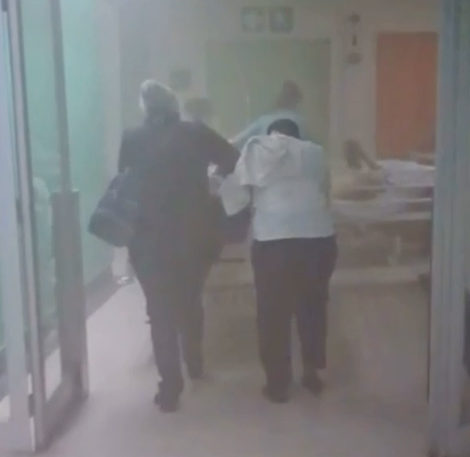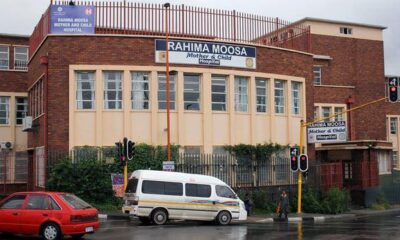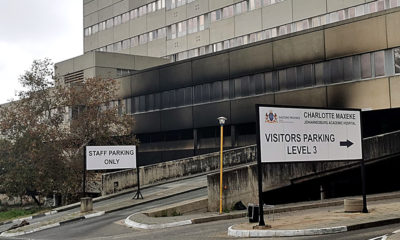
Featured Item

Charlotte Maxeke fire was like being in a movie, doctor says
Jewish healthcare workers this week described incomprehensible scenes of mayhem and camaraderie as smoke from a fire at one of Johannesburg’s biggest public hospitals forced them to rush to evacuate hundreds of patients.
The disastrous fire at the Charlotte Maxeke Johannesburg Academic Hospital (CMJAH), which broke out on Friday, 16 April, has been eclipsed by the fires which ravaged the University of Cape Town and surroundings this week.
The hospital has been temporarily shut while the extensive damage and destruction to the building is assessed. No less than 800 patients have been relocated to already over-burdened hospitals in the province.
Dozens of adrenalin-pumped healthcare workers and emergency personnel worked through last Friday night in suffocating smoke to ensure patients’ safety and continued care.
Some patients could walk, others were speedily carted around in beds, and dozens were transported in wheelchairs, many with IV drips and attached to oxygen.
Miraculously, there were no fatalities from the fire itself, but it’s believed many severely sick patients suffered during transportation to other facilities.
Professor Mervyn Mer, the head of intensive care at the hospital, was looking forward to his first weekend off in 13 months and spending time with his family when he was called with the news. He immediately helped from afar with emergency logistical arrangements.
“It has been a truly devastating saga. It’s heartbreaking for me,” he told the SA Jewish Report.
Mer was instrumental in setting up the innovative, ground-breaking intensive-care unit at the hospital last year, doubling the size of the unit and saving dozens of lives during the pandemic. His vision was to improve outcomes in the unit long after the pandemic. He doesn’t want to think about what the repercussions could be should the structural damage from the fire put an end to this dream.
“Life throws you curve balls, but you have to move forward. If we have to start again, we will. The damage is done, but the message is that the fire that was ignited in our healthcare workers to save and make a difference in people’s lives will never be extinguished,” he said.
His involvement on the day was peripheral, he said. “The real heroes were the men and women across the spectrum who were there making sure that patients’ safety came first.”
One of the Jewish doctors on call that day said nothing could have prepared her for this.
“It was an awful experience, one I will never forget,” she said.
Speaking on condition of anonymity, she said she was still recovering from smoke inhalation.
What began as a normal shift at 07:00 on Friday turned into a horror movie a few hours later.
“At about 09:00, I was working in one of the clinics on the fifth floor when I smelt smoke and it began to irritate my airways. I thought at that stage we should clear out, but people said the fire was under control,” she said.
This couldn’t have been further from the truth.
“Two hours later, the nursing sisters told us to move our cars. I started to fill out scripts and tell patients to come back as they couldn’t just wait in the smoke.”
She said there was heavy smoke throughout the day.
At about 16:00, she was needed in one of the wards on the ninth floor in Green Block.
“I noticed the lift was full of smoke, so I decided to take the stairs. The corridors were full of smoke, and so was a lift shaft coming from the parking lot all the way up to the ward.”
“There was confusion, we didn’t know where the smoke was coming from, and didn’t know where to take our patients. We were literally in the dark. We decided to take patients to the other side of the building by the entrance on the ground floor to get fresh air.
“The whole night was spent moving patients. At one point, they were breaking windows to get air. Some lifts weren’t working. At one stage, I was genuinely scared the building would give way. This was disaster management, nothing could have prepared me. People came from their homes to help. It made a huge difference, we had a great team.
“It felt like a movie the whole time. At some point, I thought things would slow down but they never did. I was running on adrenalin. I didn’t realise how much smoke I was taking in until much later.”
A Jewish senior trauma surgeon said it was a logistical challenge to relocate hundreds of patients.
Also wishing to remain anonymous, she said, “I was involved from the outside with contingency plans and moving patients. We started by making plans to move patients to the other side of the hospital. As the day progressed and the fire worsened, it became too hot for the firefighters and we realised the building itself may lose structural integrity. We then started plans to evacuate the entire hospital.”
There was a united front with additional help from the private sector, she said.
“We managed to find hospital beds throughout the province. Some of our sicker patients were transported with nursing staff to continue their care. The evacuation went on through the night. By late Saturday morning, we had emptied most of the hospital.
“Initially there was confusion about what to do. A lot of extra doctors came to help, and there was a strong sense of leadership. It’s a compliment to the medical and emergency fraternity that the operation went off fairly seamlessly without casualties. When the going gets tough, people in their numbers show up and go above and beyond,” she said.
Intensive-care nurse Ricki-Lee Serebro wasn’t on call when the fire broke out.
“Seeing your ‘home’ on fire is the most terrifying experience,” she said, “especially when it was happening and we didn’t know how bad it would get and how far it would spread. Even though I wasn’t at work, I was stressed about our patients and my colleagues and all the stock including PPE [personal protective equipment], which has been like gold this past year. I’m in awe of the hospital management, doctors, and nurses who transferred the patients so quickly to other hospitals.
“At the moment, I’m working in Steve Biko Academic Hospital in Pretoria. The commute takes a lot longer – it’s more than 50km compared to 10km to the CMJAH. Being in a different hospital is exciting as we are learning different ways of doing things, however we are disorientated so everything takes longer. We miss our home. Hopefully we will be back there soon.”
Dr Barri Strimling, who recently moved to the Chris Hani Baragwanath Hospital from the CMJAH said, “The CMJAH is a very special place. We have all given hours of our life to that facility. COVID-19 has taught us to think on the spot, and go to plan B. It has blown my mind how medical personnel and emergency services managed to orchestrate this evacuation to perfection. They are true heroes.”
Health Minister Zweli Mkhize said the blaze had caused severe damage to parts of the hospital. PPE to the value of R40 million that was stored at the hospital was lost in the fire. The cause of the fire and the extent of the damage is being investigated.










